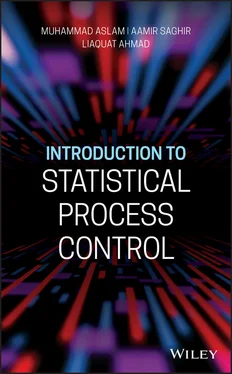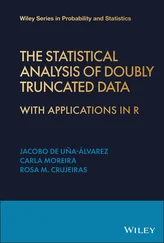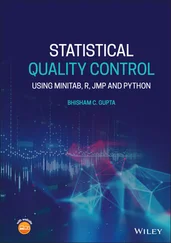Liaquat Ahmadis currently working as an associate professor in the Department of Statistics and Computer Science, University of Veterinary and Animal Sciences (UVAS), Lahore, Pakistan. He has published 35 research articles in highly reputed international impact factor journals. He has also reviewed more than 30 articles of international journals in the field of statistics. His areas of interest are quality control charts, acceptance sampling plans, experimental design, biostatistical data analysis, and statistical softwares.
This book is about the use of modern statistical methods for quality control. It provides comprehensive coverage of the subject from basic principles to state‐of‐the‐art concepts and applications. The objective is to give the reader a sound understanding of the principles and the basis for applying them in a variety of situations. Although statistical techniques are emphasized throughout, the book has a strong engineering and management orientation. Extensive knowledge of statistics is not a prerequisite for using this book. Readers whose background includes a basic course in statistical methods will find much of the material in this book easily accessible.
The book originally grew out of our teaching, research, and consulting in the application of statistical methods for various fields, particularly for industries. It is designed as a textbook for students enrolled in colleges and universities, who are studying engineering, statistics, management, and related fields and are taking a first course in statistical quality control. The basic quality control course is often taught at the junior or senior level. All the standard topics for this course are covered in detail. We have also used the text materials extensively in programs for professional practitioners, including quality and reliability engineers, manufacturing and development engineers, product designers, managers, procurement specialists, marketing personnel, technicians and laboratory analysts, inspectors, and operators.
The book contains eight chapters. Chapter 1is an introduction of history and background of control charts. This chapter also includes descriptive statistics, the basic notions of probability and probability distributions, and types of control charts. These topics are usually covered in a basic course in statistical methods; however, their presentation in this text is from the quality engineering viewpoint. It describes that quality has become a major business strategy and that organizations that successfully improve quality can increase their productivity, enhance their market penetration, and achieve greater profitability and a strong competitive advantage. Chapter 2presents the Shewhart‐type attribute control charts for counts. It highlights the importance of attribute data and presents the proper use of statistical methods to implement quality control. Concept of dispersed data is introduced, and control charts used for monitoring over‐ or under‐dispersed data are discussed along with application in industries.
In Chapter 3, control charts for monitoring the variable data processing are presented with basic concepts and implantation on real data sets. These Shewhart control charts certainly are not new, but its use in modern‐day business and industries is of tremendous value. Chapter 4contains the new idea of control charts for multiple dependent state (MDS) sampling. The MDS sampling showed the efficiency of the attribute control chart over the traditional Shewhart attribute control chart in terms of average run length. The use of MDS sampling in the area of control chart has increased the sensitivity of the control charts to detect a small shift in the manufacturing process. For decision‐making, it uses the current subgroup information and previous subgroup information to make the decision about the state of the process. In Chapter 5, exponentially weighted moving average (EWMA) control charts using repetitive group sampling scheme are introduced. The methods for EWMA‐based control charts for a variety of situations, such as the average and the dispersion monitoring charts, single sampling, double sampling, multiple sampling, sequential sampling, repetitive sampling, ranked set sampling, and the MDS sampling charts have been developed in this chapter.
Chapter 6presents the different sampling schemes used to construct the control charts. Some of these sampling schemes are very simple to develop and understand, while some schemes are much complex to develop and understand. Each of the sampling schemes has advantages and disadvantages; therefore the quality control personnel can select according to the situation and the available resources. The use of modern statistical software has made a very simple task of developing a control chart for the non‐statisticians' quality control personnel as there is no need to develop and understand the complex sampling schemes. In Chapter 7, memory‐type control charts for monitoring attributes, such as the cumulative sum chart, the EWMA chart, and the moving average charts, are given with application in industries. Chapter 8contains the material related to multivariate process control schemes. Nowadays, in industry, there are many situations in which the simultaneous monitoring or control of two or more related quality process characteristics is necessary. Monitoring these quality characteristics independently can be very misleading.
Throughout the book, guidelines are given for selecting the proper type of statistical technique to use in a wide variety of situations. Additionally, extensive references to journal articles and other technical literature should assist the reader in applying the methods described.
Muhammad Aslam
Aamir Saghir
Liaquat Ahmad
May 2020
The writing of this book was a challenging task and needed many months of concerted efforts, which involved long working hours for which our families sacrificed tremendously over this long period of time. We thank them for their patience and understanding.
We first recognize Elisha Benjamin, the project editor; Kathleen Santoloci, associate editor; and Mindy Okura‐Marszyck, senior editor, at Wiley, for providing many invaluable advice and help during the writing of this book. They have always been very kind and prompt with their replies for our queries. We like to sincerely thank both of them from the bottom of our hearts.
Professor Muhammad Aslam would like to thank Professor Munir Ahmad (Late) of NCBAE, Lahore, Pakistan, who is his a professor, mentor, coauthor, and a friend who had introduced him to this line of research. He would also like to thank Professor Chi‐Hyuck Jun of Pohang University of Science and Technology, South Korea, who is his coauthor, mentor, and friend. He thank the Department of Statistics, Faculty of Science, King Abdulaziz University for providing excellent research facilities and his colleagues in the university Dr. Saeed A. Dobbah, Professor Ali Hussein AL‐Marshadi, Professor Mohammed Albassam, Professor Kushnoor Khan, and his colleagues from UVAS, Lahore, Pakistan, Professor Muhammad Azam, Professor Liaquat Ahmad, and Dr. Nasrullah Khan for their constant encouragement.
The authors gratefully thank all the publishers from which some tables and figures were reproduced in the book.
Finally, the authors are grateful to their parents and their families and their respective wives.
1 Introduction and Genesis
1.1 Introduction
Quality improvement is a continuous process adopted in all business activities for two purposes: to compete the market and to maximize the profits. It is a competitive tool used for improving and controlling many organizations, transportation, health care, and government agencies. A goods and services providing agency delighted its customers by improving and controlling its quality, which dominates over its competitors. Shewhart control charts are used for this purpose, but according to experts of quality control, the process should not be disturbed until sound statistical inference evidence is used for indicating that the process is misbehaving. Without statistical evidence the process should not be modified. Consistent quality improvement can be sustained not only by modification of the process but also by redesigning of the process. The process design can only be changed after the full satisfaction of the quality control personnel who is running the process fully in control state ( Figure 1.1).
Читать дальше












